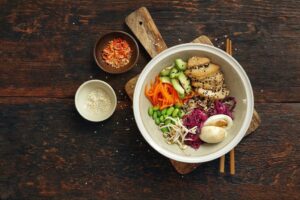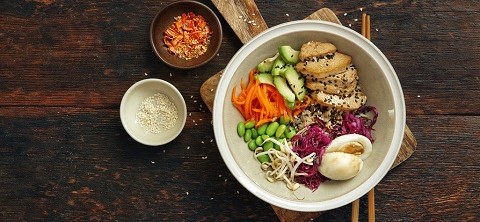

Some meals are well-known for being nice protein sources: eggs, rooster, beef, fish, peanut butter, Greek yogurt and even almonds.
However there are lots of lesser-known protein-packing meals to contemplate, like lentils, quinoa, peas, spinach, black beans, chickpeas and edamame.
There’s rather a lot to study powering up with protein, which is a nutrient we want each day and one of many primary constructing blocks of a nutritious diet.
Corewell Well being dietitian Kristi Veltkamp presents protein ideas–together with a number of new, more healthy methods we would contemplate working it into our eating regimen.
How a lot protein do I want each day?
Effectively, it relies upon–in your measurement, gender, age, exercise degree and extra.
That stated, the beneficial day by day allowance of protein for a sedentary grownup is 0.8 grams of protein per kilogram of physique weight, or 0.36 grams per pound. So, to calculate your day by day protein consumption, multiply your weight in kilos by 0.36.
That implies that the typical sedentary man ought to eat about 56 grams of protein per day, and the typical girl ought to eat about 46 grams.
Individuals over the age of 60, extremely lively folks, and those that are attempting to construct muscle mass, may want extra, Veltkamp stated.
When ought to I devour most of my protein?
Some folks like to start out the day with a protein-packed breakfast. In the meantime, many Individuals devour most of their protein at dinner.
Ideally, unfold it out as evenly as attainable, Veltkamp stated.
“Your metabolism is working all day, so we have to give it that provide from protein. You probably have little chunks of protein all through the day, your physique will be constructing and repairing all day.”
Balancing protein with carbohydrates all through the day can even allow you to really feel glad longer and helps stability your blood sugar so you aren’t getting spikes, Veltkamp stated.
Some methods to try this with snacks: apples with peanut butter, a path mixture of your favourite nuts or seeds with dried fruit or darkish chocolate chips, carrots with hummus, or Greek yogurt with berries.
Can I get an excessive amount of protein?
That’s sophisticated. Veltkamp stated that most individuals simply get the beneficial quantity of protein in a given day.
Think about this: the beneficial portion measurement of meat as a part of a wholesome meal is 3 to five ounces–in regards to the measurement and thickness of the palm of your hand or a deck of playing cards.
And that alone is round 25 grams of protein–midway to the typical beneficial day by day quantity.
“We usually get that very simply and may exceed that,” Veltkamp stated.
The issue comes not essentially in an excessive amount of protein, however in the place that protein is coming from, she stated.
“An excessive amount of protein tends to be animal protein,” she stated. “It’s arduous to overeat once we’re consuming plant-based protein.”
And an excessive amount of animal protein can result in increased quantities of ldl cholesterol, saturated fats and energy, which results in the next danger of coronary heart illness, colon most cancers, stroke and diabetes, in addition to different dangers.
Additionally, extra protein is saved as fats and may result in weight achieve or stop weight reduction.
In the meantime, consuming extra plant-based meals presents advantages together with sustaining a wholesome weight, improved intestine well being, boosted immune system, diminished irritation, extra vitamin and mineral content material, no ldl cholesterol, and extra fiber.
The largest factor Veltkamp stated she talks about with many individuals is consuming extra crops.
“Make animal proteins a aspect merchandise in your plate,” Veltkamp stated. “Three ounces is lots for a serving. And select a lean choice such a poultry or seafood. Then load up extra in your plant consumption as a result of that’s the place most of your well being advantages are going to return from.”
A rule of thumb to make that straightforward to recollect: divide your plate into one-quarter lean and wholesome protein equivalent to rooster breast, one-quarter starch or entire grain equivalent to brown rice or baked potato, and the remaining half fill with greens.
What are some non-meat protein sources?
The listing is lengthy, Veltkamp stated.
Think about these, listed with the quantity of protein per 1 cup serving:
- Chickpeas or hummus, 20 grams
- Pink lentils, 18 grams
- Black beans, 18 grams
- Shelled edamame, 18 grams
- Quinoa, 16 grams
- Brown rice, 10 grams
- Inexperienced peas, 9 grams
- Spinach, 4 grams
In case you’re feeling extra adventurous, you may flip to tofu, which presents 9 grams of protein per three ounce serving, or tempeh, which has 16 grams per three ounce serving.
One other tip from Veltkamp: whole up all of the protein in your meal earlier than you add meat, and also you is likely to be shocked how a lot is there already.
Veltkamp identified that some nations’ diets–together with these in locations the place folks historically dwell the longest–are based mostly on plant-based proteins.
And one other bonus for going plant-based: animal protein equivalent to meat and eggs are costly proper now.
“A can of beans is less expensive,” she stated.
It is likely to be time to start out enthusiastic about new sources of protein and discover a stability that works for you.

